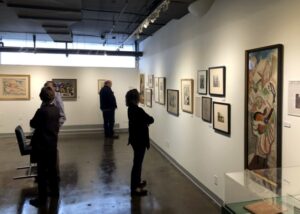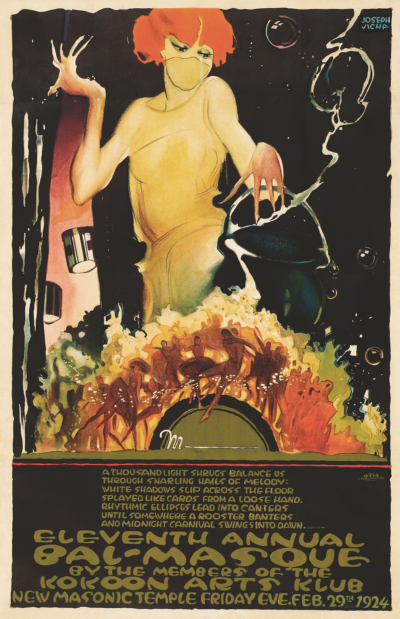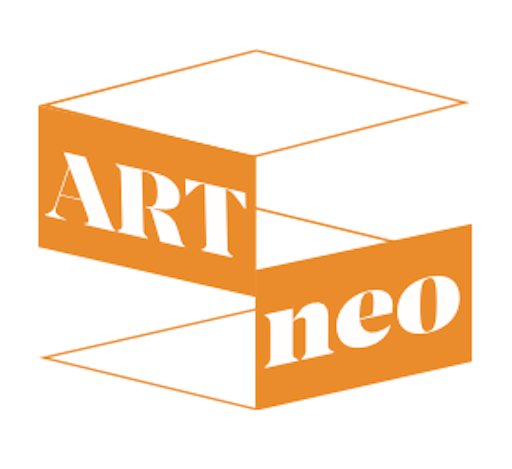Current Exhibition

THE CLEVELAND SALON 1920 – 1924
Opening: April 19, 2024
On View Through July 22, 2024
The Cleveland Salon, 1920-1924 is on view through July 20, 2024 at ARTneo, 1305 W 80th St, Cleveland, OH 44102 and from September 23 through December 13, 2024 at Kelvin Smith Library, Case Western Reserve University, 11055 Euclid Avenue, Cleveland, OH 44106.
In the 1920s, Cleveland was having an artistic revival, with the bookshop of Richard Laukhuff as its center. Laukhuff had opened his little bookshop full of books, prints, and European art magazines in 1916. It quickly became a meeting place for local artists, a small group of whom decided to form a salon. Their self-styled “salon” lasted only a few years, but its influence had a profound impact, bringing the modern in painting, poetry, theater, and architecture not only to Cleveland but to the nation at large.

It was William Lescaze (1896-1969), a Swiss born-American architect, who initially proposed that his group of like-minded friends should meet regularly to discuss the latest trends in art. The most senior and influential member of the group, at 54, was the painter William Sommer (1867-1949), who worked six days a week as a lithographer. Known as ‘Wild Bill’ to his friends, he had little interest in promoting his work and preferred to live quietly, much like his idol Cezanne, in the countryside, amid the rolling hills of his Ohio farm.
The poet, Hart Crane (1899-1932), was one of Sommer’s most promising protégés. Free of the depressive feelings that would haunt his later years, he was known in Cleveland for both his modernistic verse and wild escapades. Dubbed the salon’s “major domo,” he could barely contain his excitement on a 1921 visit to Sommer’s Brandywine studio, writing, “It has been a day I shall not soon forget. . . I have been so dazzled …”.
The other leading member of the group—Richard Rychtarik (1894-1982)-had been trained as an architect. A Czech national, Rychtarik had spent some time in Berlin before the outbreak of World War I, observing theater productions at the Max Reinhardt Theater. Although he would later garner national recognition for his revolutionary theater designs at New York’s Metropolitan Opera, in Cleveland, he supported himself by designing ads for the Sherwin Williams paint company.

The salon often met in Crane’s apartment, his “ivory tower” where they discussed the interrelation of the arts late into the night. Crane sometimes mused that poetry could also be heard in colors. Later in life, he spoke of his poem Atlantis as reflecting Goethe’s aperçu that architecture is ‘frozen music.’ In effect, the group was leaning on the theory of “synesthesia,” a neurological singularity in which the stimulation of one sense causes the automatic experience of another sense. Sommer himself was convinced that one could literally see music as colors and attempted to translate his love of Bach and Wagner into the visual. Sommer often declared he could see in color the various movements of the music as it was played.
The group of friends was not content to theorize; its members wanted to put their views into practice. They were offered such an opportunity by the recently formed Cleveland Play House, the Kokoon Club’s masked Bals, and the Cleveland Art Museum’s May Show.
By 1923 each of the artists was striving to realize their own individual vision. Crane had begun his first drafts of his major work The Bridge. Adopting the Brooklyn Bridge as the poem’s sustaining symbol, he strived to create an uplifting celebration of contemporary life.
Lescaze met George Howe, a prominent Philadelphia architect, and together they created a first in modern American architecture, a thirty-three-story glass skyscraper for the Philadelphia Saving Fund Society bank. Completed in 1932, the building was a breakthrough Richard Rychtarik in turn rose to prominence through his work in theater. A student of music as well as architecture and literature, he found early success in designing for both The Cleveland Play House and the Cleveland Orchestra. As a scene designer, he combined architectural forms, distinctive colors, and innovative lighting. He saw the realistically painted backdrops that characterized American operatic settings as out of date and believed that the stage designer should instead embrace the fantasy of the opera.
Rychtarik’s vision of creating an imaginary world on stage would soon influence opera design nationwide. In 1949 Rychtarik’s career took a dramatic shift as he was recruited by CBS as chief scenic designer for its television programs. He would go on to design the sets for Studio One in Hollywood 1948-1953 and most notably The Honeymooners 1955-1956. In his television work Rychtarik continued to embrace the modernist view about staging and apply it to his television work.
The Cleveland salon had initially been criticized, its work dismissed, and its efforts unsupported by the critics and galleries of the established art world. And yet their writings, their paintings, and their designs continue to endure. Each man put forward a new modern view for American art and each had a transformative influence on the American cultural landscape.
Author: Lawrence Waldman | Cleveland, OH

Past Exhibitions
From Kokoon to Butterfly: 100 Years of Remarkable Cleveland Art, 1.19.24-3.20.24
Emergence: New Sculptures of Eva Kwong, 8.18.23-10.20.23
A Sweet and Sour Journey with Elmer W. Brown and Langston Hughes, 5.16.23-7.24.23
John W. Carlson: A Retrospective, 9.16.22-11.4.22
CAN Triennial You Are Here, 7.8.22-8.31.22
Selections From ARTneo’s Collection, 2.18.22-5.20.22
Drawn To Clay: The Alchemy of the Elements, 10.15.21-1.21.22
Strange and Lonely Spaces: Magic Realism in Cleveland 1930-1960, 5.21.21-8.20.21
Christine Mauersberger & Evan Graham: Screenscapes, 11.20.20-3.19.21
Oppositions: The Secessionist vs. The Cleveland Society of Artists, 7.3.20-10.16.20
Time Travel: New Works from David King, 12.7.19-2.21.20
Outside the Mainstream: Douglas Max Utter, 9.13.19-11.15.19
States of Expression: Prints from the ARTneo Collection, 6.21.19-8.16.19
Continuum: The Art of the Cleveland School and Beyond, 3.15.19- 5.17.19
Continuum: The Art of the Cleveland School and Beyond, 3.15.19- 5.17.19
Recent Acquisitions 2018, 11.16.18-2.15.19
Day Job: The Working Artist, 8.17.18–10.19.18
Three Angles: A History of Cleveland Art, 7.7.18-7.29.18
Time, Space, & Life: Works by David Buttram and Deborah Silver, 5.18.18-6.15.18
Gloria Plevin: A Life in Art, 2.16.18-4.20.18